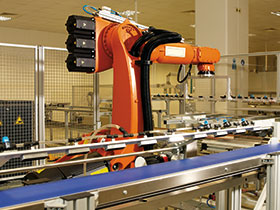

Since 1986, LabVIEW has been an industry-leading software development environment that helps engineers and scientists build test, measurement, and embedded systems to solve the world’s challenges. Through the power of graphical programming, LabVIEW users solve grand challenges, such as how to monitor the condition of power grids to keep the lights on, how to automate mobile device testing to keep our world connected, and how to build the factories of the future that will usher in the next great industrial revolution. Devices are being added to these systems at an alarming rate where Cisco estimates that by 2022, one trillion devices will be connected in the Internet of Things (IoT). As their number of devices increases, these systems grow not only in size but also in complexity and new challenges for system design. These intricate systems must be networked together to facilitate communication for intelligent decision making.
With expansive, complicated systems, we can’t waste time sending data up the chain for each component to wait for further instruction. Decisions need to be made on the node, but this cannot happen without increasing data analytics capabilities to create more intelligent devices. With this intelligence, individual components in a system can analyse and adapt to their surroundings to prevent failure or optimise efficiency and also communicate the adaptation to other affected devices in the system. For example, a robotic arm on a production line could change its control algorithm to compensate for a worn joint and then notify other robotic arms down the line of the operation change and new wear pattern to identify.
Who wants useless data?
System designers have taken advantage of recent communication technology advances to connect devices that before were isolated from the rest of the world. The IoT relies on these advances to create systems in which devices can talk with each other. Our robotic arm cannot only share information with other robots, but also immediately notify offsite engineers of any production changes due to joint wear. Connectivity requirements make it necessary to implement wireless protocols, particularly in systems where just a few years ago, network compatibility was not considered at all.
As system complexity and communication evolves, the need for synchronisation among the devices becomes even more vital to system health. Complex systems will have tighter time constraints, potentially down to the millisecond, to prevent system failure. Synchronisation protocols need to be introduced into a greater number of connected systems to ensure timing requirements are met and data is communicated at the right time. Without a synchronisation mechanism in place, the data devices transmit to each other is useless.
LabVIEW 2015 provides a reliable, high-performance graphical system software solution to help make engineers and scientists who face these new challenges more productive.
Reliable solution for the IoT
The Central Advanced Research and Engineering Institute at the Hyundai Motor Group is using LabVIEW to design wearable robots to assist people who experience difficulty walking because of knee or hip impairments. While developing the robot, the research team encountered challenges that are becoming more common to system designers in the age of the IoT. The robot’s design requires many sensors to collect data from its surrounding environment. The data needs to be quickly processed to influence the performance of the actuators moving the system. By developing the application using LabVIEW, the team was able to use real-time data from the sensors to perform complex control algorithms to regulate multiple actuators. Using NI Data Dashboard, the team provided wearers with an interface to interact with and adjust the robot’s settings to their personal preferences. The research team at Hyundai needed to not only implement real-time data analytics and wireless capabilities for the robot, but also be efficient in their development.
“Using LabVIEW and the LabVIEW RIO architecture allowed us to reduce the time of developing and testing a new robot control algorithm to just one week, compared to one month with a text-based approach. We are able to prototype with software and hardware faster and adapt to rapidly changing control requirements quicker,” said DongJin Hyun of the Hyundai Motor Group.
LabVIEW played an integral role in helping this research team efficiently develop a wearable robot that takes advantage of the IoT.
New features in LabVIEW 2015
LabVIEW 2015 introduces key innovations to meet the challenges facing engineers who are creating, designing, and testing the IoT. Interested readers can visit www.ni.com/labview/whatsnew for an overview of the new features.

© Technews Publishing (Pty) Ltd | All Rights Reserved